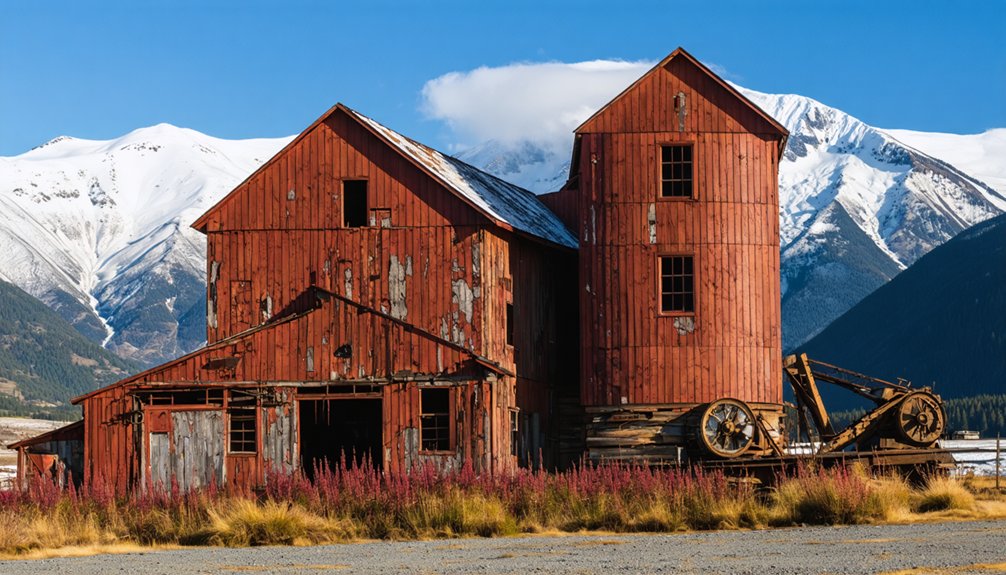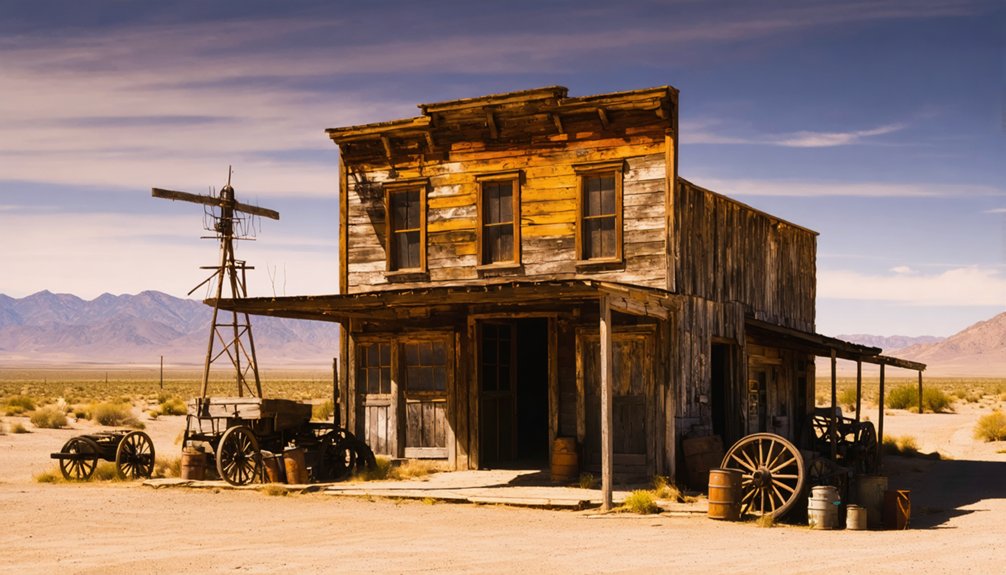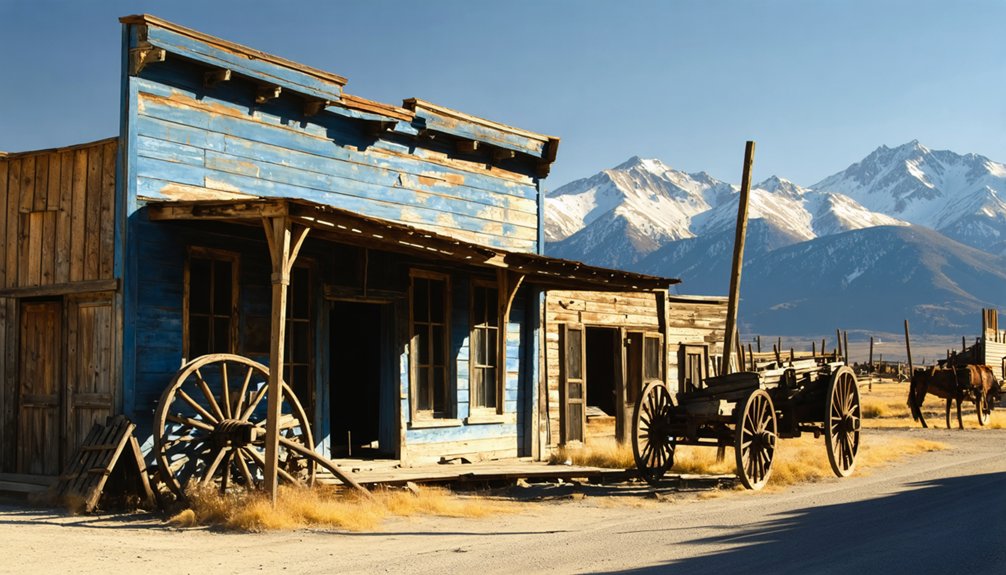Western ghost towns offer remarkable scenic backdrops that combine historical architecture with stunning natural landscapes. At Bodie, California, preserved structures stand against Sierra Nevada foothills, while Saint Elmo’s buildings frame majestic Rocky Mountain vistas at nearly 10,000 feet elevation. Bannack presents gold rush remnants alongside Grasshopper Creek’s natural beauty, and Kennecott’s copper mill creates dramatic industrial contrasts against Alaskan glaciers. Each location presents unique photographic opportunities where America’s frontier past meets natural grandeur.
Key Takeaways
- Bodie, California offers 110 preserved structures with original furnishings against the Sierra Nevada backdrop, emphasizing conservation over restoration.
- Saint Elmo’s 9,600-foot elevation provides year-round photography opportunities with optimal afternoon lighting and stunning Rocky Mountain vistas.
- Bannack State Park features original gold panning locations and intact frontier architecture alongside scenic riverside hiking trails.
- Kennecott’s 14-story copper mill creates dramatic industrial compositions against Alaska’s glacial landscape, especially during morning and evening alpenglow.
- Fall and spring offer ideal ghost town photography conditions with warm hues enhancing weathered textures and fresh vegetation contrasting abandoned structures.
The Preserved Splendor of Bodie: California’s Arrested Decay Wonder
Nestled in the eastern foothills of California’s Sierra Nevada mountains, Bodie stands as America’s preeminent exemplar of the “arrested decay” preservation philosophy.
Following W.S. Bodey’s gold discovery in 1859, the settlement transformed from a small camp into a thriving boomtown of 10,000 residents by 1880, producing over $38 million in precious metals.
Today, you’ll witness Bodie’s authentic Wild West character through approximately 110 surviving structures, complete with original furniture and goods—a snapshot frozen in time.
Step back in time as Bodie’s 110 preserved structures reveal genuine Wild West life, frozen at the moment of abandonment.
The town’s notoriety for lawlessness was evident with 60 saloons operating during its peak years.
Designated a National Historic Landmark in 1961, this ghost town preservation marvel maintains its original state without restoration, only conservation.
As you explore streets where miners and outlaws once roamed, Bodie history comes alive, offering an unvarnished glimpse into California’s gold rush era.
Visitors should be aware of the famous Bodie Curse that supposedly brings misfortune to anyone who removes artifacts from the site.
Dramatic Mountain Backdrops of Saint Elmo, Colorado
When you visit Saint Elmo, you’ll encounter pristine alpine vistas with the Sawatch Range’s towering peaks forming a dramatic natural theater around this well-preserved ghost town.
The surrounding Chalk Cliffs and dense aspen groves create compelling compositions regardless of season, with each offering distinct photographic opportunities—golden autumn foliage, snow-draped buildings in winter, or wildflower-dotted landscapes in summer.
Despite its 9,600-foot elevation, the town remains accessible year-round through scenic mountain roads, allowing photographers and history enthusiasts consistent access to this remarkable convergence of historical architecture and Rocky Mountain grandeur. Originally named Forest City in 1878, Saint Elmo features numerous preserved buildings that create captivating subjects against the mountain backdrop.
Visitors who arrive in the late afternoon hours are rewarded with softer lighting conditions that enhance the weathered textures of the historic structures while avoiding both the midday heat and potential thunderstorms common to the region.
Pristine Alpine Scenery
Deep within the heart of Colorado’s Sawatch Range, Saint Elmo stands as a monument to mining-era ambition, surrounded by some of the most spectacular alpine scenery in the Rocky Mountains.
Positioned near the Continental Divide at high elevation, you’ll find yourself encircled by dramatic sandstone Chalk Cliffs that form a natural amphitheater around the settlement.
The landscape offers a stunning juxtaposition of elements: dappled sunlight filtering through aspen forests, lichen-covered rocks contrasting with weathered structures, and delicate alpine flora carpeting the fragile mountain soils.
Just beyond the main town, a five-minute walk reveals breathtaking mountain vistas and river views along Chalk Creek.
This pristine watershed remains central to the region’s ecosystem, sustaining the same environmental patterns that supported the original mining operations. The town’s elevation of 9,961 feet provides visitors with thin, crisp mountain air and spectacular panoramic views year-round. Visitors can access Hancock and Alpine Tunnel Roads, which connect history with high-country views while attracting outdoor enthusiasts during the dry season.
Year-round Photo Opportunities
Saint Elmo’s remarkable year-round accessibility transforms it into a photographer’s sanctuary unlike most abandoned mining settlements in the American West.
While snow isolates many ghost towns during winter months, County Road 162 remains consistently plowed, allowing your vehicle direct access to this preserved tableau regardless of season.
The Sawatch Range provides a commanding backdrop, with the Continental Divide and Colorado’s highest peaks framing your compositions throughout the year.
Spring delivers wildflowers against weathered wood, summer offers dramatic afternoon thunderstorms, autumn bathes the 43 original structures in golden aspen light, and winter cloaks the town in pristine snow.
This seasonal photography paradise presents the authentic interiors, vintage signage, and architectural details against ever-changing mountain vistas—allowing your lens to capture the timeless dialogue between human endeavor and alpine grandeur. Visitors can further enhance their experience by exploring the town’s rich historical tales while capturing its photogenic elements. The town, established in 1871 by miners, continues to stand as one of Colorado’s best-preserved ghost towns, making it a must-visit for history enthusiasts and photographers alike.
Bannack’s River Valley: Gold Rush Remnants Amid Natural Beauty
As you explore Bannack State Park‘s river valley, you’ll discover original gold panning locations along Grasshopper Creek where fortune seekers first congregated in 1862, triggering Montana’s territorial establishment.
The remarkably intact frontier architecture—including the jail, courthouse, and mining structures—stands as evidence to the boom-and-bust cycle that defined Western expansion during the nineteenth century. Visitors can see the Bannack Masonic Lodge No. 16 schoolhouse built in 1874, which served for decades as an educational center during the town’s transition from mining hub to ghost town.
Riverside hiking trails wind through the preserved townsite, offering contemplative views of the same landscape that witnessed vigilante justice, Indigenous conflicts, and the everyday struggles of frontier life. The area is now preserved by Montana State Parks, ensuring this significant piece of gold rush history remains accessible to future generations.
Frontier Gold Panning Spots
The shimmering allure of Bannack’s Grasshopper Creek beckons modern visitors to experience firsthand the excitement that drew thousands to this remote valley in 1862.
You’ll be panning in the same waters where Montana’s gold rush began—where early prospectors staked historic claims along a unique geological formation where granite meets limestone, creating extraordinarily pure gold deposits reaching 99.5% purity.
Join supervised panning sessions offered summer weekends at Bannack State Park, where you’ll learn authentic panning techniques while keeping any precious metal you discover.
Beyond Bannack, adventurous souls can explore nearby Alder Gulch, site of Montana’s largest strike, or try your luck at Libby Creek and various gulches throughout Helena National Forest.
Each location carries its own geological signature, promising both historical connection and the perpetual thrill of potential discovery.
Preserved Mining Structures
Standing as sentinels to Montana’s gilded past, Bannack’s remarkably preserved mining structures offer visitors an unparalleled glimpse into industrial-scale gold extraction that transformed this river valley from wilderness to boomtown in the 1860s.
As you explore the valley floor, you’ll encounter rusted dredge buckets and historical artifacts scattered across fields—tangible evidence of the hydraulic operations that once churned through Grasshopper Creek’s mineral-rich sediment.
The preserved dredge pond, which freezes during winter months providing recreational opportunities, represents the engineering ingenuity of early prospectors.
This landscape of preserved machinery extends beyond extraction equipment to include the architectural framework of commerce: the Ovit General Store, blacksmith shops, and the brick courthouse all stand as proof of a community that once supported 10,000 souls in pursuit of prosperity.
Riverside Hiking Trails
Winding through Bannack’s historic riverine landscape, the network of trails along Grasshopper Creek offers hikers a unique convergence of natural splendor and gold rush heritage.
As you traverse the moderately difficult Bird’s Eye View Trail, you’ll experience diverse river valley ecosystems while retracing routes once traveled by determined miners seeking fortune.
- Navigate the 3-mile loop with proper preparation—rattlesnakes inhabit these terrains, making hiking safety tips essential for your wilderness adventure
- Witness seasonal transformations as wildflowers blanket spring meadows and autumn paints the valley in golden hues
- Discover interpretive signage revealing how this waterway shaped Bannack’s destiny, with visible remnants of dredging operations that extracted precious metals
For ideal exploration, plan your visit during spring through early fall when daylight extends and trails reveal maximum biodiversity along Grasshopper Creek’s verdant banks.
Alaska’s Frontier Wilderness: Photographing Kennecott’s Copper Legacy

Nestled within the rugged wilderness of Wrangell-St. Elias National Park stands the crimson mill buildings of Kennecott, offering photographers unparalleled historic industrial compositions against Alaska’s dramatic mountain backdrop.
This copper mining marvel operated from 1911 to 1938, extracting over 600,000 tons of high-grade copper and generating up to $300 million in value during its heyday.
You’ll find the fourteen-story mill building particularly enchanting, its festive red façade contrasting brilliantly against the glacial landscape.
Frame your shots to capture the architectural details preserved since Kennecott’s abandonment in 1938.
Visit during morning or evening hours when alpenglow bathes the structures in golden light while the Kennicott and Root Glaciers provide stark environmental contrast.
The site’s National Historic Landmark status recognizes it as the finest remaining example of early twentieth-century copper mining worldwide.
Desert Mystique: Capturing Mogollon’s Rugged Charm
Deep within New Mexico’s rugged Mogollon Mountains lies the hauntingly beautiful ghost town of Mogollon, where photographers can capture the convergence of Wild West history and dramatic desert landscapes.
Perched at 6,500 feet elevation and accessed via a winding nine-mile gravel road through Silver Creek Canyon, this former mining boomtown offers unparalleled visual narratives of America’s frontier spirit.
When photographing Mogollon’s history and rugged landscapes, you’ll discover:
- Dramatic vantage points showcasing abandoned mines like the notorious Little Fanny Mine against steep canyon walls
- Weathered structures that survived devastating fires and floods, evidence of the resilience of frontier communities
- Historic cemetery dating from the 1890s that silently chronicles the town’s violent past, including Spanish influenza victims and mining casualties
Golden Light: Oregon’s Unique Church-Centered Mining Town

While New Mexico’s Mogollon captures the untamed spirit of Western mining towns, Golden, Oregon presents photographers with a striking historical contrast worth exploring. Founded in the 1890s by Reverend William Ruble’s family, this remarkable settlement defied mining town stereotypes by establishing a temperance-focused church community amid gold rush fervor.
You’ll find the well-preserved 1892 Campbellite church standing as evidence to the town’s religious foundations—a stark contrast to typical mining camps. The absence of saloons and presence of family orchards reflect Golden’s unique moral vision.
As you photograph the historic structures managed by Oregon Parks, you’ll document a mining heritage that yielded an estimated $20 million in precious metals while maintaining strict Christian values. This National Historic Site offers unparalleled views of a rare morality-centered boomtown.
Best Seasons and Times for Ghost Town Photography
When should you venture into ghost towns for best photographic results? The seasonal effects on these abandoned settlements dramatically influence your visual narrative.
Fall (September-November) offers peak natural light with warmer hues that enhance weathered textures, while spring introduces vibrant contrasts between aged structures and renewed vegetation.
The seasons paint abandoned towns differently—fall’s golden palette embraces decay while spring’s revival creates poignant juxtapositions against weathered remnants.
For the most compelling images, consider:
- Golden hour (shortly after sunrise/before sunset) creates dramatic shadows and warm directional light that accentuates architectural details.
- Blue hour (twilight) produces ethereal atmospheres perfect for evoking the haunting nature of abandoned places.
- Overcast conditions deliver soft, even illumination perfect for capturing textural details without harsh contrast.
Avoid summer middays when harsh light flattens shadows and winter’s short daylight hours in remote locations where access may become problematic.
Frequently Asked Questions
Are Any Ghost Towns Genuinely Haunted With Documented Paranormal Activity?
You’ll find documented hauntings in places like Bannack and Garnet, Montana. Haunted legends persist where paranormal investigations have captured voices, apparitions, and physical interactions—scientifically monitored phenomena tied to historical traumas.
What Safety Precautions Should Visitors Take When Exploring Remote Ghost Towns?
Always inform others of your route plan. You’ll need sturdy footwear for unpredictable terrain hazards, and respiratory protection inside buildings. Be prepared for wildlife encounters with noise-makers and maintain distance from unstable structures.
Can Visitors Legally Collect Artifacts or Souvenirs From Ghost Towns?
You can’t legally collect artifacts from ghost towns. Just as you value your own possessions, artifact preservation requires leaving items in place. Legal restrictions protect these historical treasures for everyone’s future understanding and enjoyment.
Which Ghost Towns Are Accessible Year-Round Despite Harsh Weather Conditions?
You’ll find weather resilience at Terlingua and Calico with year-round desert accessibility, while Garnet and South Pass City maintain accessible routes despite snow, offering winter recreation opportunities through maintained trails.
How Do Local Indigenous Communities View Tourism at Neighboring Ghost Towns?
Indigenous communities often view tourism with ambivalence—valuing economic opportunities while concerned about sacred site protection. Their cultural perspectives emphasize consented visibility, self-representation, and mitigating negative tourism impact through Indigenous-led stewardship.
References
- https://explorethearchive.com/western-ghost-towns
- https://en.wikipedia.org/wiki/Wikipedia:WikiProject_Ghost_towns
- https://www.united.com/en/us/hemispheres/places-to-go/5-western-ghost-towns.html
- https://m.dresshead.com/files/scholarship/Documents/Ghost_Towns_Lost_Cities_Of_The_Old_West_Shire_Usa.pdf
- https://mwg.aaa.com/via/places-visit/western-ghost-towns
- https://www.youtube.com/watch?v=qRVelHci92k
- https://www.geotab.com/ghost-towns/
- https://bbb7.lpc.events/papersCollection/publication/fetch.php/Ghost Towns Of The West A Sunset Pictorial.pdf
- https://en.wikipedia.org/wiki/Lists_of_ghost_towns_in_the_United_States
- https://en.wikipedia.org/wiki/Wikipedia:WikiProject_Ghost_towns/Assessment



